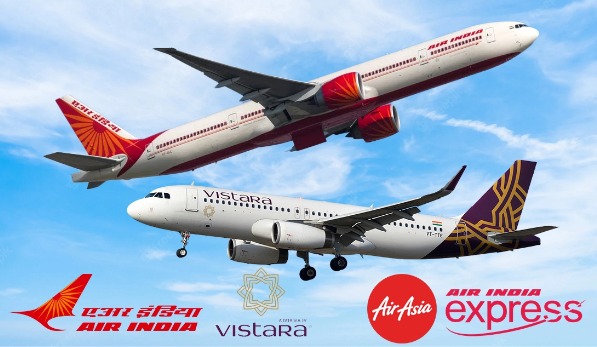
On Tuesday, Singapore Airlines announced an Air India merger with Vistara by March 2024. Tata Group owns 51% of Vistara, and Singapore Airlines holds the remaining 49% of the company’s stock (SIA). SIA will also invest Rs 2,058.5 crore in Air India as part of the deal “
As a result, SIA would hold a 25.1% share in an expanded Air India company that would have a sizable presence in all important market categories.
In March 2024, SIA and Tata want to finalise Air India merger with Vistara, subject to regulatory approvals “According to SIA’s announcement.As soon as this integration is finished, SIA will invest $250 million, giving the new Air India a $1 billion valuation.
SIA stated that it intended to fund the entirety of this investment from internal cash resources, which as of September 30, 2022, totaled S$17.5 billion (Singapore dollars).
“The Air India merger with Vistara is a major milestone in our path to establish Air India as a truly world-class airline,” said N Chandrasekaran, chairman of Tata Sons. With the goal of providing outstanding customer experiences to each and every customer, we are reinventing Air India.
Chandrasekaran added that as part of the transformation, Air India is putting more of an emphasis on expanding both its network and fleet, redesigning its customer proposition, and improving safety, reliability and on-time performance.
The chief executive of Singapore Airlines, Goh Choon Phong, stated that one of the most reputable and well-known names in India is Tata Sons. Our joint efforts to establish Vistara in 2013 produced a market-leading full-service carrier that has quickly garnered numerous awards on a worldwide scale.
“With this combination, we have the chance to strengthen our bond with Tata and take part directly in the aviation market’s exciting new growth phase in India. Together, we will support Air India’s transformation program, tap into its enormous potential, and help it regain its status as a preeminent airline on the international stage.
This will bring the total number of aircraft in the fleet to 218 and combine Air India’s 113 with AirAsia India’s 28 and Vistara’s 53. According to Tata Sons, it will then be the second-largest domestic and international carrier in India.
According to reports, one of the biggest orders in aviation history, for 300 narrow-body jets that would be delivered gradually, is likely to be placed. In the next five years, Air India plans to quadruple its current fleet of 113 aircraft, according to its chief executive officer.
This is a significant step in the Tatas’ efforts to rebuild Air India, a business they founded and later nationalised before regaining control over it when the government decided it would be best to sell it off due to mounting losses.
It will be business as usual during integration process: Vistara CEO
Vistara CEO Vinod Kannan stated on Tuesday that all of its stakeholders will continue doing business as usual while the integration process, which will take some time, is underway. This statement came shortly after Tata Group announced the Air India merger with Vistara
Vistara is a wonderful expression of its parent companies Tata Sons and Singapore Airlines, according to a statement from Kannan, and “we are thrilled that we will continue to be influenced by their legacies when we join with Air India.”
“The integration process will take some time, and throughout this period, all of our stakeholders, including customers, can continue doing business as usual.
As necessary, we will continue to provide pertinent information with each of them, he said.
With the united entity’s size and network, an airline group has a tonne of potential. In addition to promoting Indian aviation on a worldwide scale, we look forward to giving our clients, team members, and partners more chances.
Vistara, a full-service airline, with a market share of 9.2% in October and was the second-largest domestic airline in the nation. With a fleet of 54 aircraft, the airline currently connects 43 domestic and international locations and runs more than 260 flights per day. About 4,700 people work there.
Journey of Air India so far:
Talace Private Limited, a Special-Purpose Vehicle (SPV) of Tata Sons, is the owner of Air India. Following a successful offer at an auction in 2021, Tata Sons acquired the airlines from their prior owner, the Government of India.
Air India was sold to Talace Private Limited, a Tata Sons’ SPV, for Rs 18,000 crore, along with its low-cost carrier Air India Express and 50% of AISATS, a ground handling firm. On January 27, 2022, the airline was formally transferred to the Tata Group.
The airlines fly to 102 domestic and international locations with a fleet of Airbus and Boeing aeroplanes. Along with several key cities throughout the nation, Air India’s hub is located at Indira Gandhi International Airport in New Delhi.
With a market share of 18.6%, it is the biggest international airline operating out of India.
JRD Tata established the airline as Tata Airlines in 1932. After the Second World War, it changed its name to Air India and became a public limited company. The Government of India purchased 49% of the airline in 1948 following the attainment of Indian independence in 1947. Later in 1953, Centre passed the Air Corporations Act and acquired Tata Sons’ majority ownership of the airline.
According to the Directorate General of Civil Aviation’s market report for October 2022, the three Tata group airlines—Air India, Vistara, and AirAsia India—had a combined market share of 25.9%.
In recent months, Air India and Vistara have been battling it out for second place in Indian airspace. Vistara was able to hold the position for four months in a row, but it was unable to surpass the 10% threshold in October as it had in July.
Air India, meanwhile, made huge gains last month and trailed Vistara by just 0.1 percent. The difference, measured in absolute numbers, was only 11,000 passengers.





